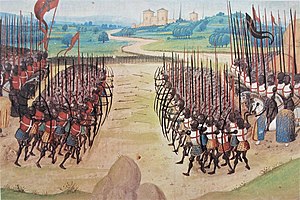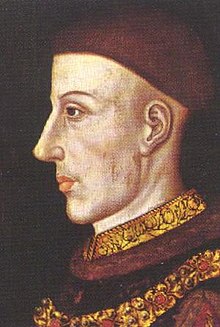Battle of Agincourt
50.46361111112.14166666667Coordinates: 50° 27′ 49″ N, 2° 8′ 30″ E
Battle of Azincourt
Part of: Hundred Years War

Contemporary representation (Enguerrand de Monstrelet)
Objectives: French attempt to stop the English invasion and destroy the English on their way to Calais.
Battles of the
Hundred Years War
(1337-1453)
1st phase 1337-1386
Channel and Flanders (1337-1340): Cadzand - Arnemuiden - Channel - Sluis
Chevauchées of the 1340s: Saint-Omer - Auberoche
Edward III campaign (1346/47): Caen - Blanchetaque - Crécy - Calais
War of the Breton Succession (1341-1364): Champtoceaux - Brest - Morlaix - Saint-Pol-de-Léon - La Roche-Derrien - Tournament of the Thirty - Mauron - Auray
France Allies: Neville's Cross - Les Espagnols sur Mer - Brignais
Chevauchées of the 1350s: Poitiers
Castilian Civil War & War of the Two Peter (1351-1375): Barcelona - Araviana - Nájera - Montiel
French counteroffensive: La Rochelle - Gravesend
Wars between Portugal and Castile(1369-1385): Lisbon - Saltés - Lisbon - Aljubarrota
2nd phase 1415-1435
Henry V campaign (1415): Harfleur - Azincourt
Battle for Northern France: Rouen - Baugé - Meaux - Cravant - La Brossinière - Verneuil
Joan of Arc and the turn of the war: Orléans - Battle of the Herrings - Jargeau - Meung-sur-Loire - Beaugency - Patay - Compiègne - Gerberoy
3rd phase 1436-1453
French victory: Formigny - Castillon
The Battle of Azincourt (French Bataille d'Azincourt, English Battle of Agincourt) took place on October 25, 1415, on Saint Crispinian's Day, near Arras in what is now the Pas-de-Calais department of northern France. The troops of King Henry V of England fought against the army of King Charles VI of France, various French noble lords and the Armagnacs. It was one of the greatest military victories of the English over the French during the Hundred Years War.
The Battle of Azincourt is unusually well documented for a medieval battle. The precise location of the main battle is undisputed; there is uncertainty about the chronology only in matters of detail. The number of participants in the battle, on the other hand, has long been disputed, as chronicles differ widely here. For nearly 600 years, however, the consensus was that the Anglo-Welsh army was vastly outnumbered by French troops. Modern historians have often assumed a 4:1 balance of forces in favor of the French side. Recent research by British historian Anne Curry disputes this. In a departure from previous doctrine, she argues (based on documented pay) that the French army outnumbered the Anglo-Welsh army by only a 3:2 ratio of forces. The exact balance of forces, however, remains in dispute.
The Battle of Azincourt is considered one of the most significant battles in military history because - as previously at the Battle of Crécy - foot troops armed with longbows played a decisive role in the outcome of the battle. The attack of the French heavy cavalry remained ineffective not least because of the massive use of the longbowmen, i.e. the attack of the heavily armed French nobles was slowed down and impaired by their use. France's military defeat was so lasting that Henry V was able to impose the Treaty of Troyes on France in 1420, which gave him a claim to the French throne through the marriage of the French king's daughter Catherine of Valois.
Background
Causes of the dispute
The starting point and core point of contention of the Hundred Years' War, of which the Battle of Azincourt is a part, was the English claim to the French throne. After the English victories at Crécy (1346) and Maupertuis (1356), the first phase of this war ended with the Peace of Brétigny, concluded in 1360, which secured English rule over large parts of France. By 1396, the French had recovered much of the land they had lost to the English and secured it through a renewed peace treaty with England. Henry V, who ascended the English throne in 1413, renewed the claim to the French kingdom and resumed diplomatic talks to that end while recruiting an army of experienced soldiers paid directly by the English crown. After diplomatic negotiations broke down, he and his army landed at Harfleur (now the Seine-Maritime department) in Normandy on August 14, 1415.
On the French side, he was opposed by the insane King Charles VI. Among his imperial administrators were the Duke of Burgundy, John Fearless, and the Duke of Orleans, Charles de Valois, who with their parties of Bourguignons and Armagnacs fought a power struggle that almost paralyzed the French side in the war against the English. The town of Harfleur, besieged by the Anglo-Welsh army, was not helped by any French army and the town surrendered on September 22. Although a mobilization of the feudal armies in the French provinces took place after the fall of Harfleur, the armies of the dukes of Orleans and Burgundy would probably have fought each other if they had met. Thus, the army of the Burgundian Duke John Fearless remained behind and the Connétable, Charles I d'Albret commanded the French force.
The English march to Azincourt
About a third of the Anglo-Welsh army was dead or unable to fight after the week-long siege of Harfleur. With a remnant army weakened from day to day by an epidemic of rest, Henry V wanted to move to Calais, which had been the last bastion of the English crown in northern France since 1396. There he wanted to prepare himself for coming hostilities. The direct route from Harfleur to Calais was about 200 kilometers and led along the coast. Only the Somme represented a major obstacle on this route. In order to cross this river above the estuary, the Anglo-Welsh army moved further inland from October 13.
Along the Somme, French troops had occupied the crossings in time, so the English force had to penetrate further and further inland in search of a way to cross the Somme. It followed the course of the river, however, the French army on the north bank of the Somme kept pace with it. Henry V therefore decided to stop following the course of the river and, in order to throw off the French army, crossed the Santerre plain in a forced march. Near the towns of Bethencourt and Voyennes, they found two unguarded, though damaged, dams that allowed them to cross the Somme. By this time they had covered 340 km in twelve days. Therefore, Henry V let his army rest on October 20. From October 21 to 24, the army covered another 120 km. Henry V was aware that the French army must be on their right flank. Scouts were able to confirm this assumption on October 24. Although the French had already formed up in battle formation on October 24, the battle did not take place because of nightfall. The two armies camped within earshot of each other during the very rainy night.

Charles VI of France. Detail of an illumination from a manuscript codex created around 1412. Geneva University Library

Henry V of England. Anonymous portrait, late 16th or early 17th century. National Portrait Gallery (London)
Effect of the defeat
Militarily, France was so soundly defeated that the English regent Henry V was able to impose his war aims in the following years, occupying Caen and finally, five years later, imposing the Treaty of Troyes on the French crown, by which he married the French princess Catherine of Valois and made himself the successor of the French king Charles VI.
The scale of France's defeat also led to a realignment of Burgundian policy, which came to fruition in the Treaty of Troyes in 1420. The King of England was recognized by the Burgundians as King of France in order to work towards the formation of an independent empire.
Literary and cinematic processing
- The battle is thematized in William Shakespeare's Henry V. This play has been filmed three times under the original title. In 1944 by and with Laurence Olivier and in 1989 by and with Kenneth Branagh. In 2012, the English-only series The Hollow Crown was released, consisting of Shakespeare's works Richard II, Henry IV Pt1 & Pt2, and Henry V.
- In the novel The Sign of Victory by Bernard Cornwell, the battle is described in detail from the perspective of an English archer. Filming of a movie adaptation directed by Michael Mann was scheduled to begin in 2013.
- In the novel The Keepers of the Rose by Rebecca Gablé, the battle takes up a small part of the plot. The depiction here is from the point of view of a young English nobleman.
- In the science fiction novel The Resistance by David Weber, the prologue depicts the battle from the point of view of a fictional herbivorous alien race.
- The film The King (2019) focuses on the reign of Henry V and the Battle of Azincourt.
Search within the encyclopedia